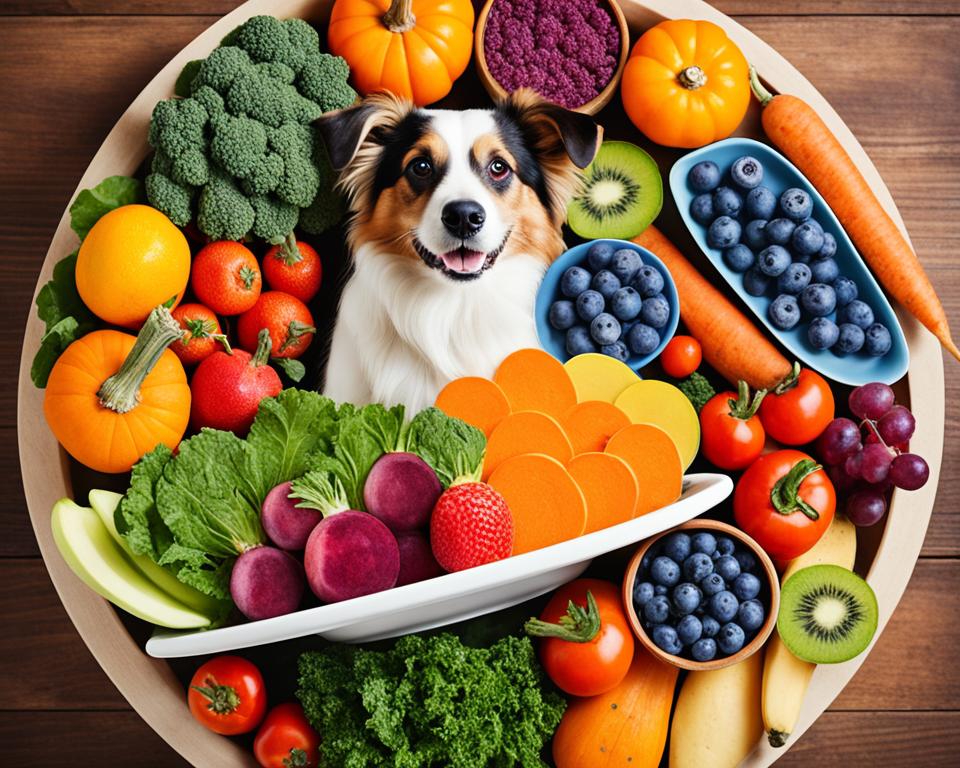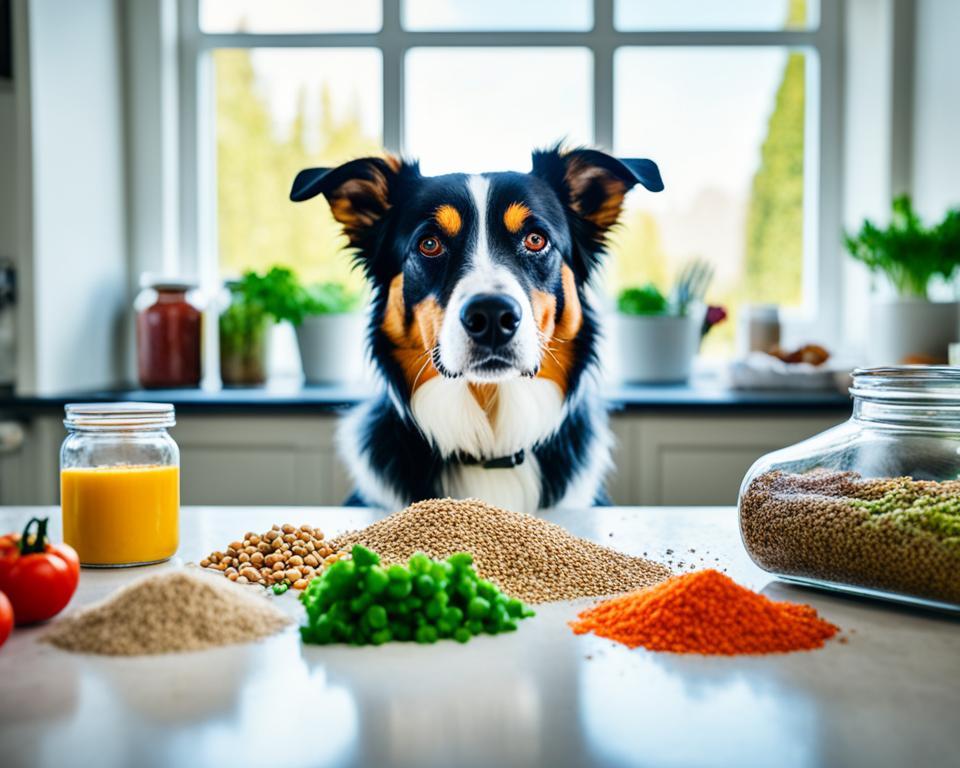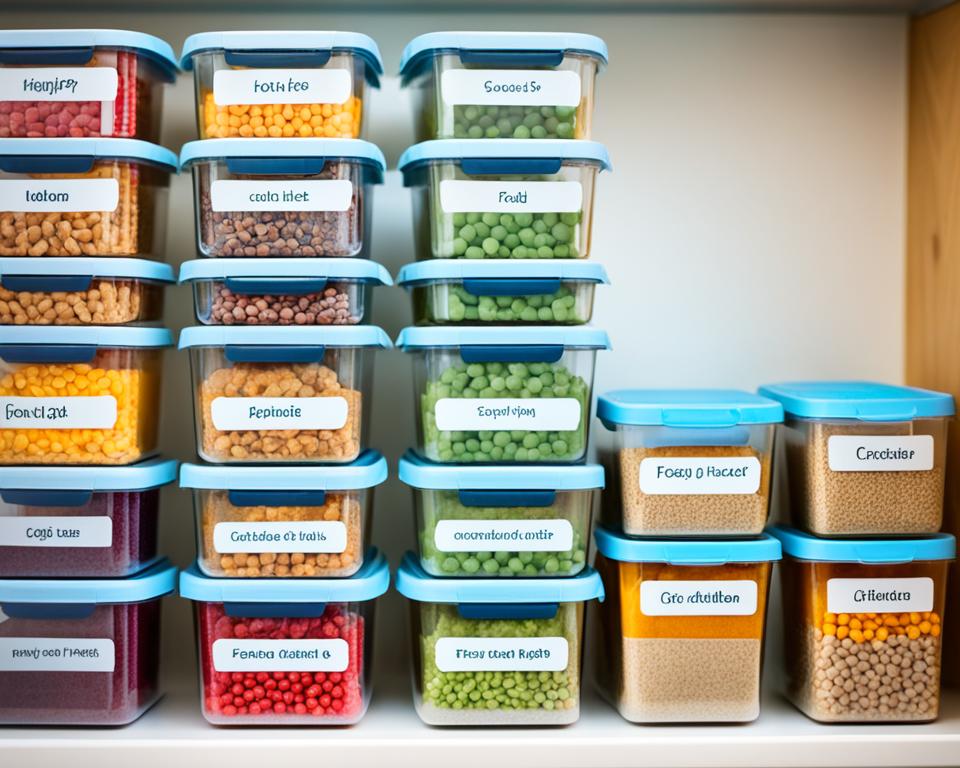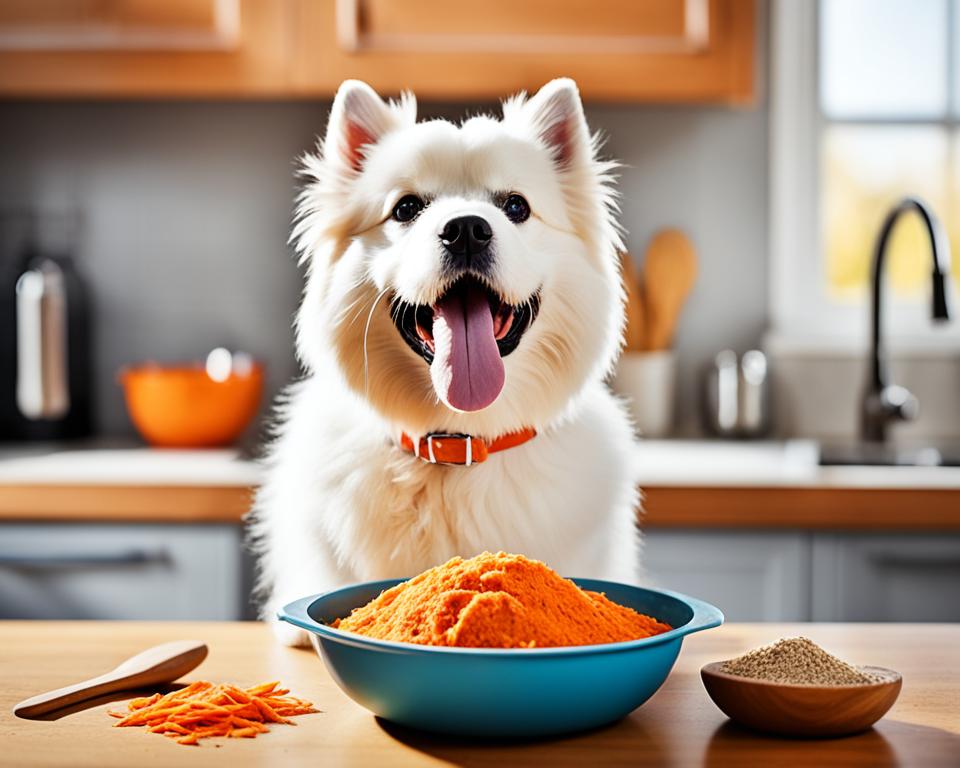I’ve found a big change for pet owners: making pet food at home! It’s a trend that’s catching on fast. This guide has 71 pages full of simple recipes. It lets you control what your pet eats.
Homemade pet food is smart for those who care about their pets’ health. It uses natural stuff to make food that fits your pet’s needs. And it can save money compared to buying it.
One recipe I tried makes food for a 45-pound dog for three days. It’s easy: just mix ground turkey, veggies, and rice. This meal has 240 calories per cup, helping keep your dog healthy.
These recipes offer lots of variety and are fun to make. They use ingredients you likely have at home. Your pet gets yummy, healthy food, and you know what’s in it.
The Benefits of Homemade Pet Food
Making my own pet food has many benefits. It lets me control what my pet eats. This ensures they get the best nutrition.
Control Over Ingredients
I know exactly what goes into my pet’s food when I make it myself. I pick fresh, whole ingredients. This avoids additives and preservatives in store-bought food. It helps me keep my pet’s meals safe and high quality.
Customization for Dietary Needs
Every pet is different and has unique dietary needs. Making meals at home lets me adjust the ingredients for my pet. This is great for managing weight, allergies, or health conditions. Homemade pet food is very flexible.
Cost-Effective Alternative
Homemade pet food might seem expensive at first, but it can save money over time. For example, a family with two Labrador Retrievers could spend $1,000 a month on store-bought food. But making meals at home can cut costs, especially when buying ingredients in bulk.
“A home-cooked diet can add as much as 32 months to a dog’s life expectancy.”
There are big health benefits too. Dogs eating homemade diets may live almost three years longer and have less arthritis. With simple recipes and meal prep, I’m helping my pet live a healthier, happier life.
Essential Nutrients for Your Pet’s Health
Understanding what your pet needs for good health is key. A balanced diet for dogs includes protein, carbs, fats, vitamins, minerals, and water. Let’s look at what makes a healthy meal for your pet.

Protein is vital for pets. Good sources are meat, poultry, fish, eggs, and dairy. Carbs come from grains like rice and quinoa, and veggies such as zucchini and green beans. Fruits like blueberries and cranberries are good too.
Fats are important for your pet’s skin, coat, and energy. I use vegetable oils, fish oil, or animal fats in my recipes. Vitamins and minerals help with digestion, immunity, and bone health. They come from fruits, veggies, and organ meats.
| Nutrient | Sources | Benefits |
|---|---|---|
| Protein | Meat, poultry, fish, eggs | Muscle development, tissue repair |
| Carbohydrates | Rice, quinoa, vegetables | Energy, fiber for digestion |
| Fats | Vegetable oils, fish oil | Skin health, energy, coat condition |
| Vitamins & Minerals | Fruits, vegetables, organ meats | Immunity, bone health, overall wellbeing |
When making organic pet food at home, I use fresh, quality ingredients. I cook the food to avoid illness. Then, I store it in airtight containers in the fridge or freezer to keep it fresh.
Every pet is different. I suggest talking to a vet nutritionist for a diet plan just for your pet. This way, you make sure your pet gets the best nutrition.
Homemade Pet Food Recipes
I love making homemade dog food for my furry friend. It’s a great way to ensure they get the best nutrition while keeping things tasty. Let’s explore some delicious and healthy pet treats you can whip up at home.
Chicken and Vegetable Stew for Dogs
This hearty stew is packed with protein and veggies. I combine chicken, carrots, green beans, and potatoes in a slow cooker. It’s a nutritious meal that dogs love.
Turkey and Sweet Potato Dog Treats
These treats are perfect for training. I mix ground turkey with mashed sweet potatoes, form small balls, and bake them. They’re healthy and easy to make.
Peanut Butter Banana Dog Treats
Dogs go crazy for these! I blend ripe bananas with natural peanut butter, add some whole wheat flour, and bake until golden. They’re a hit every time.
Carrot Apple Dog Treats
These crunchy treats are great for dental health. I grate carrots and apples, mix with oat flour, and bake until crisp. They’re packed with vitamins and fiber.
Blueberry Oatmeal Dog Biscuits
For a antioxidant boost, I make these biscuits. I combine oats, blueberries, and a bit of honey. They’re tasty and beneficial for your dog’s health.
| Recipe | Main Ingredients | Prep Time | Cooking Method |
|---|---|---|---|
| Chicken and Vegetable Stew | Chicken, carrots, green beans, potatoes | 15 minutes | Slow cooker |
| Turkey and Sweet Potato Treats | Ground turkey, sweet potatoes | 20 minutes | Baked |
| Peanut Butter Banana Treats | Bananas, peanut butter, whole wheat flour | 15 minutes | Baked |
| Carrot Apple Treats | Carrots, apples, oat flour | 25 minutes | Baked |
| Blueberry Oatmeal Biscuits | Oats, blueberries, honey | 30 minutes | Baked |
Preparing Homemade Cat Food
Many cat owners are now making their own cat food. In fact, 72% of them are thinking about or have switched to homemade food. They do this because of allergies and their cat’s special diet needs. Let’s look at some tasty and healthy recipes using natural ingredients.
Salmon and Sweet Potato Cat Meal
This recipe mixes omega-3 rich salmon with sweet potatoes. Cats need about 26% protein, mostly from animals. Salmon gives them this protein and healthy fats. Sweet potatoes add complex carbs, keeping them energetic.
Chicken Liver Pate for Cats
Chicken liver pate is a protein-rich treat cats adore. It’s full of vitamins and minerals. Cats need about 9% fat, which comes from animals like chicken. This recipe meets that need and tastes great.
When making homemade cat food, getting the right balance of nutrients is key. Cats need 10% carbs and 6% fiber for their health. I add taurine supplements to my recipes, as 85% of recipes suggest this amino acid is vital.
It takes me 2 to 3 hours to make a batch of homemade cat food. I make extra and freeze it for later, a tip from many recipes. Making my own cat food lets me control the ingredients and meet my cat’s needs. This ensures my cat stays healthy and happy.
Incorporating Natural Ingredients in Pet Food
I love making organic pet food for my furry friends. It’s amazing how natural ingredients can boost their health and happiness. Let’s explore some fantastic options to create nutritious meals for our pets.
When crafting homemade pet food, I aim for a balance. I mix 50% cooked protein, 25% raw veggies, and 25% cooked complex carbs. This mix ensures my pets get all the nutrients they need.
For proteins, I use lean beef, turkey, or chicken. Vegetables like carrots and sweet potatoes add fiber and vitamins. Brown rice or quinoa serve as excellent complex carbs.
I’ve discovered some surprising natural ingredients that offer great benefits. Coconut oil improves skin and coat health, while turmeric supports joint function. Broccoli contains sulforaphane, which can slow down osteoarthritis in dogs. These simple additions make a big difference in my pets’ overall well-being.
“Homemade pet food allows me to control exactly what goes into my pet’s diet, ensuring they get the best nutrition possible.”
Safety is crucial when preparing organic pet food. I always cook pork to 140°F and poultry or beef to 165°F. It’s important to avoid onions, garlic, and seeds from fruits or nuts, as they can be harmful to pets.
Instead, I add pet-friendly herbs like basil, dill, and parsley for flavor and added health benefits.
By incorporating these natural ingredients into my pets’ diets, I’ve noticed improvements in their energy levels and overall health. It’s rewarding to know I’m providing them with the best nutrition possible through homemade, organic pet food.
Tips for Transitioning to Homemade Pet Food
Switching to homemade pet food can really change your pet’s health. It’s important to do it carefully for the best results. Here are some tips to help you switch smoothly.
Gradual Introduction
Start by adding homemade food slowly. For dogs, mix in 25% new food on day 1. Then, add more on day 3 and day 5. By day 7, they should eat 100% homemade food. Cats might need 14 days to adjust, but follow the same steps.
Monitoring Your Pet’s Response
Watch your pet closely as they get used to new food. Look for changes in how they feel, their coat, and their poop. Most pets get healthier eating homemade food. If your pet seems worse, slow down the change.

Consulting with a Veterinarian
Talk to a vet before changing your pet’s diet. Most vets suggest getting advice to make sure your pet gets the right nutrition. They can adjust the diet for your pet and recommend supplements.
| Pet Type | Transition Period | Day 1 | Mid-Point | Final Day |
|---|---|---|---|---|
| Dogs | 7 days | 25% new food | 50% new food (Day 3) | 100% new food |
| Cats | 14 days | 25% new food | 50% new food (Day 10) | 100% new food |
Every pet is different. Some pets adjust fast, while others take longer. By following these steps, you’re helping your pet move to a healthier diet.
Homemade Pet Treats for Special Occasions
I love giving my furry friends special treats on big days. Making them at home is fun and lets me pick the ingredients. Let’s check out some easy recipes for celebrating with our pets!
Peanut Butter and Banana Popsicles are a hit for hot summer days. They’re easy to make and my dogs love them. I mix yogurt, mashed banana, and natural peanut butter, then freeze it in molds.
For pets feeling stressed or with joint pain, I make CBD dog treats. They’re good for anxious pets or those with joint issues. But, always talk to your vet before giving CBD to your pet.
- 45% of homemade pet treat recipes contain pumpkin
- 40% are no-bake recipes
- 30% include peanut butter as a key ingredient
- 25% use oats for added nutrition
When making treats, I think about what’s best for my pets. For example, I use whole wheat flour for peanut butter cookies. But, I pick different flours for pets with wheat allergies. These treats keep fresh in the fridge for two months or the freezer for eight months.
Remember, treats should be a small part of your pet’s diet. With these easy recipes, you can make tasty, healthy treats for any special day!
Storing and Preserving Homemade Pet Food
Proper storage is key for homemade pet food. It keeps the food fresh and safe. This way, our pets get the best nutrition.
Proper Storage Techniques
I store my pet’s meals in airtight containers in the fridge for short-term. This keeps the food fresh for 4-5 days. For bigger batches, I freeze them in containers or bags. This keeps the food good for 3-5 months.

Freezing and Thawing Methods
Freezing homemade pet food in single servings is easy. When it’s time to thaw, I use the fridge. It’s key to label containers with the date to keep track of freshness.
| Storage Method | Duration | Best Practices |
|---|---|---|
| Refrigeration | 4-5 days | Use airtight containers |
| Freezing | 3-5 months | Portion into single servings |
| Thawing | Overnight | Use refrigerator method |
Homemade pet food recipes make about 11 pounds. This lasts nearly 3 weeks for two small dogs. By following these tips, your pet’s meals will stay fresh and nutritious.
Common Mistakes to Avoid When Making Pet Food
Making homemade pet food can be tricky. Many pet owners make mistakes that could harm their pets. Let’s look at some common errors to avoid when preparing meals for your pet.
One big mistake is not balancing nutrients properly. Dogs need about 40 essential nutrients for optimal health. Skipping ingredients or making substitutions without expert advice can lead to nutritional deficiencies. It’s crucial to follow recipes from trusted sources or consult with a veterinary nutritionist.
Another error is using harmful ingredients. Some foods that are safe for humans can be toxic to pets. Avoid using onions, garlic, chocolate, grapes, raisins, and xylitol in your pet’s food. These can cause serious health issues or even be fatal.
| Safe Ingredients | Unsafe Ingredients |
|---|---|
| Lean meats | Onions |
| Vegetables | Garlic |
| Whole grains | Chocolate |
| Fruits (in moderation) | Grapes/Raisins |
| Eggs | Xylitol |
Overfeeding is another common mistake. Homemade meals can be calorie-dense, leading to obesity if portions aren’t controlled. Remember, a balanced diet is key to good pet nutrition. Always measure ingredients and follow serving size recommendations.
Lastly, neglecting essential supplements is a serious oversight. Many homemade pet food recipes lack vital nutrients found in commercial foods. Adding supplements ensures your pet gets all the necessary vitamins and minerals for a healthy life.
The Future of Homemade Pet Nutrition
I’m excited about the future of pet nutrition, especially homemade meals. More pet owners are taking charge of their pets’ diets. This leads to diets made just for each pet’s needs.
Organic pet food is getting more popular. Pet owners want locally sourced, sustainable ingredients. It’s about feeding pets the best nature offers.
We’ll see new advances in nutritional science soon. This will make homemade pet food even better. We’ll get meals that perfectly balance proteins, fats, and carbs.
For dogs, this means 60% protein, 30% carbs, and 10% fat. For cats, it’s 60% protein, 30% animal fat, and 10% carbs. The future of pet nutrition looks bright. I’m excited to be part of it, making pets healthier and happier.

